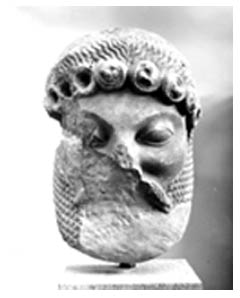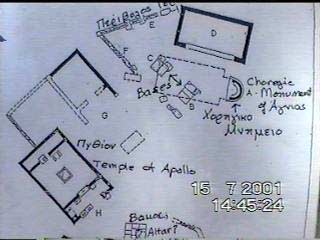
Archaic marble mask of Dionysos from the Sanctuary of Dionysos, Ikaria
(National Archaeological Museum, Athens)
The
Ikarion Sanctuary of
Dionysos
Vomos
Dionysos (Ikaria), Northern Athens, Attiki, Greece
INTRO1: Dionysos
- Mythology and Images
INTRO2:
Festivals of Dionysos
Reconstruction progress photos - Apr. 2006
Reconstruction progress photos - Jun. 2004
Reconstruction progress photos - Dec. 2001
Reconstruction
progress photos - Oct. 2001
Reconstruction
progress photos - July 2001

Archaic marble mask of Dionysos from the Sanctuary of Dionysos, Ikaria
(National Archaeological Museum, Athens)

Archaeologist's plan of the site in Ikaria (now part of the modern Dionysos area)
Background Information
The
site is dedicated to Dionysos & the Pythian Apollo and was founded in the
fourth Century BC (i.e. from 300-400 year BC) so it is at least 2,300 years
old. The ancient name of the area was Ikaria, hence the term Ikarion Sanctuary
of Dionysos. The modern name for the area is Vomos Dionysos. Vomos means altar
or place of sacrifice.
Pythian
Apollo
The site at Ancient Delphi was based round the Sanctuary of Apollo. The Pythian
Games at Delphi grew out of a musical festival held at the theatre at Delphi
every eight years to celebrate Apollo's mythical slaying of the serpent Python.
Though poetry and musical recitals remained central to the occasion, from 582
BC athletic events in the stadium at Delphi were added and the festival became
known as the Pythian Games and were held every four years. These after the Olympic
Games held in the stadium in Olympia were the most important sporting event
in the Greek calendar. The other two athletic events in this four year (Olympiad)
cycle were held at the stadiums at Nemea and the Isthmus (at Corinth). Hence
the temple at the site in Dionysos was dedicated to Pythian Apollo .
NOTE:
The Olympic Games were born in Olympia in 776 BC (when Ifitos made a treaty
with Lycourgos the king of Sparta and Clisthenes the king of Pissa) and held
every four years until the Roman (Byzantine) Emperor Theodosius abolished them
in 393 AD (after the 293rd Olympiad i.e. they lasted for 12 consecutive
centuries) after Christianity took root and he deemed the games pagan.
Emperor Theodosius also banned the functioning of all idol worshipping sanctuaries
- which would have put an end to the ceremonies performed at the sanctuary in
Dionysos after more than 700 years.
Choregic Monuments
The person who supervised and financed the presentation of a drama in ancient Greece was called a CHOREGOS. Serving as a choregos was just one of the various public services called liturgies required of wealthy Athenians as a kind of income tax. Usually they were generous and spent more than the legal minimum. The responsibilities of the choregos were the following:
*
Provide a place to train the chorus
* House and feed chorus and actors
* Pay for costumes and props
* Pay for extra actors (mutes)
* Choose poet and aulos player from the archon's list
* Select chorus members
* Hire a chorus director, if the poet didn't do this himself
* Pay for dedication to Dionysos, if he won the drama contest
Victorious CHOREGOI (plural) set up bronze tripods to commemorate their victories
in dramatic and other choral performances. The tripods were sometimes supported
by small buildings & were called CHOREGIC MONUMENTS and dedicated to Dionysos,
the god of drama.
NOTE: The list of sponsors for programs on Greek television are called the choregoi - so the word is still in everyday use.
Attic village of Ikaria
Ikaria in Attiki (Attiki is the province that contains Athens) the site of the Sanctuary of Dionysos - is mentioned in the mythology surrounding the festivals of Dionysos.
Read about this in the special Festivals of Dionysos page (click here)
Excavations at the site
The American School of Classical Studies in Athens have carried out various excavations:
January 30 to March 9, 1888
November 13 to January 4, 1889
1981 - clean-up (plus preliminary drawings by W. Biers & Tom Boyd)